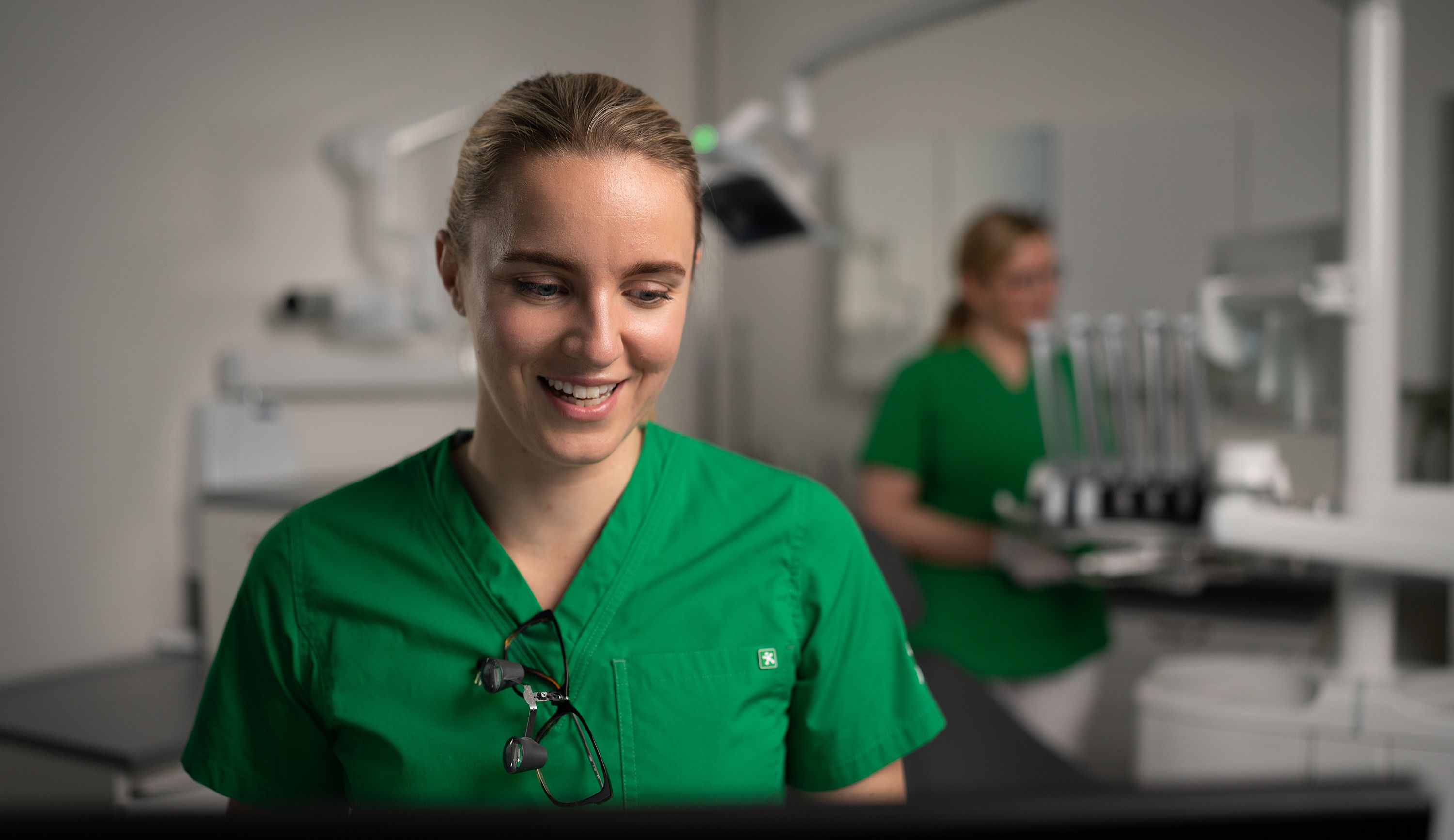
A dental implant replaces a missing tooth
Specialist in the article

Revised 1/4/2023
Dental implants in a nutshell
- A dental implant, i.e. an artificial tooth root, is often a good option when you are missing a tooth.
- The finished result requires a few visits to the dentist.
- You’ll get an implant with a perfect fit and appearance – thanks to the collaboration between our oral surgeons and prosthodontists and the latest 3D technology we use.
When should you get a dental implant?
It’s a good idea to have a missing tooth replaced if don’t like the look of the hole or it is affecting your bite.
Molars are particularly important for your bite. If you are missing a molar, its opposite tooth also cannot do anything – this means that, in a way, two teeth are missing from the bite.
The steps of fitting a dental implant
It is important that your dental implant fits perfectly in your mouth, works properly and feels like your own tooth.
This is why dental implants are carefully made and fitted step by step:
- During the planning appointments, your dentist will examine your teeth and occlusion. X-rays of your jaws and, if necessary, a cone-beam CT scan will be taken for the purpose of making a treatment plan.
- Treatment of oral issues. Before the implant is placed, the required basic dental and gum treatment will be carried out.
- Bone grafting of the jawbone and soft tissue reshaping may be necessary before implant placement. Sometimes, the modifications are done in several stages.
- The implant, i.e. artificial tooth root, is placed into the jawbone during surgery. You will, of course, be given an effective anaesthetic, so you will feel no pain. At best, the surgery itself takes just 15 minutes.
- Post-operative care appointment. When the implant screw is fitted, you will be given an appointment to have the stitches removed. During the post-operative care appointment, the dentist will also check that the initial healing has taken place as expected and go over the cleaning instructions with you.
- Impression. It usually takes about three months for the implant screw to bond to the jawbone. After that, your dentist will make an impression of your mouth. The 3D scanner gives the best possible impression of the area to be repaired.
- Making the crown. Using a digital model, a dental technician will make a personalised, perfectly fitting crown for you.
- Attaching the crown. The dentist attaches the crown to the implant screw. Your perfectly functioning and natural-looking dental implant is ready!
- The follow-up appointment takes place about a year after the implant is completed. It is important to continue to have regular dental check-ups – your dentist will advise you on the most suitable interval for you. The implant should be checked during your dental check-up.
Dental implant – preparing for the placement
During your first planning appointment, your dentist will give you clear instructions on how to prepare for the implant screw being placed in your jawbone.
Usually an hour before the procedure, you will take an antibiotic prescribed by your doctor at home to prevent the risk of infection. You should also take a painkiller to ensure that the pain relief works when the anaesthetic wears off after the procedure.
If your implant surgery is done under general anaesthesia, your anaesthesiologist will contact you well in advance of the procedure. They will give you instructions on how to prepare.
Are you nervous about seeing a dentist? It’s very common and perfectly normal. At Mehiläinen, we are committed to identifying and treating dental fear, because we want to create a good experience for you. Come to us as you are.
As of March 15, 2023, the polyclinic fee does not have to be paid after more than five reception visits during the calendar year. After the fifth payment, the polyclinic fee is 0 € for visits for the rest of the calendar year.
The Kanta fee (3,90 €) will be charged for visits to Hammas Mehiläinen starting from January 1, 2025.
If you visit our clinic and do not pay for your appointment using the available payment methods, we will send you an invoice for your appointment. The invoicing fee is 5.20 €.
If the procedure is booked with a specialist dentist, the prices are increased by 30 %.
Check out Hammas Mehiläinen's flexible payment methods
| Service | Price estimate |
|---|---|
| Dental check-up | 54,00 € Without Kela reimbursement 84,00 € |
| Dental check-up for patients with dental fear | 91,00 € Without Kela reimbursement 121,00 € |
| Children and young people dental check-up The dental check-up performed by a dental specialist. Book a dental check-up for children and young people Prices 79,00–136,85 €, without Kela reimbursement 109,00–157,00 € | 79,00 € Without Kela reimbursement 109,00 € |
| Dental X-ray of the teeth and jaws | Mobile Benefit 88,00 € The price with a doctor's referral after Kela compensation is 79 €. 109,00 € Without Kela reimbursement 118,00 ��€ |
| Tartar removal 30–45 minute appointment with a dental hygienist. Book an appointment for tartar removal Explore different payment methods Prices 130,00–183,00 €, without Kela reimbursement 138,00–195,00 € | from 130,00 € Without Kela reimbursement from 138,00 € |
| Tooth jewellery application The price does not include the price of tooth jewellery. | from 68,00 € No Kela reimbursement |
| Dental fillings 1–3 surfaces. Prices 94,00–262,00 €, without Kela reimbursement 104,00–285,00 € | from 94,00 € Without Kela reimbursement from 104,00 € |
| Ceramic filling of the tooth 1–3 surfaces. Explore different payment methods Prices 279,00–561,00 €, without Kela reimbursement 279,00–618,00 € | from 279,00 € Without Kela reimbursement from 279,00 € |
| Dental ceramic crown Laboratory costs are not included in the price estimate. Explore different payment methods Prices 616,00–798,00 € | from 616,00 € No Kela reimbursement |
| Chipped tooth Prices 94,00–262,00 €, without Kela reimbursement 104,00–285,00 € | from 94,00 € Without Kela reimbursement from 104,00 € |
| Tooth extraction Explore different payment methods Prices 109,00–732,00 €, without Kela reimbursement 119,00–794,00 € | from 109,00 € Without Kela reimbursement from 119,00 € |
| Tooth whitening Price estimate given at the free consultation appointment. Book an appointment for a free whitening consultation. Prices incl. VAT Prices 101,00–455,00 € | from 101,00 € No Kela reimbursement |
| Whitening consultation appointment Includes an individual price estimate for teeth whitening. Book an appointment for a whitening consultation. | Free No Kela reimbursement |
| Anaesthesia Prices 38,00–39,00 €, without Kela reimbursement 41,00–42,00 € | from 38,00 € Without Kela reimbursement from 41,00 € |
| Irrevocable absence Prices 74,00–96,00 € | 74,00 ��€ No Kela reimbursement |
| Initial assessment of sleep apnea Learn more about sleep apnea and book an appointment (in Finnish) | from 57,00 € Without Kela reimbursement from 84,00 € |
| Bite guard Includes clinical work and the bite guard. Prices 638,00–685,00 €, without Kela reimbursement 695,00–742,00 € | 638,00 € Without Kela reimbursement 695,00 € |
Related symptoms
Aphthae
Painful and itchy ulcer on the oral mucosa.
Bad breath
Often behind the smell is a problem that needs the help of a dentist.
Bruxism or teeth grinding
Tooth damage, sore bite muscles or headaches.
Chipped tooth
A piece of a tooth or a filling has come loose. Make an appointment with your dentist.
Dental cavity
Can feel like an enmity or a toothache - or you don't feel anything special.
Dental staining
Can be caused by a number of factors, such as cavities, enamel development disorders or foods.
Gingivitis
Bleeding from the gums, bad breath, bad taste in your mouth and sore gums.
Mucosal and oral diseases
The cause of severe or persistent mouth symptoms should be investigated by a dentist.
Periodontitis
A common disease of the connective tissue underneath the gums which is caused by gingivitis.
Sensitivity
Pricking and sudden pain, often caused by cold, hot or touching the tooth.
Tartar
Is a bacterial plaque hardened by salivary minerals.
Temporomandibular disorder (TMD)
Pain and dysfunction of the jaw joints and masticatory muscles.
Tooth enamel damage
Tooth enamel damage is caused by tooth wear or problems with biting.
Toothache
Can be caused by a cavity or an inflamed tooth, as well as a partially erupted wisdom tooth.
Other related services
Dental specialists
Are dentists who are specialised in one of the disciplines of dentistry. Specialist dentist consultation.
Dentist
Performs oral health examinations and treats oral diseases and other problems.
Emergency dental care
Emergency visit for sudden toothache, accident or other acute symptoms.
Dental hygienist
Provides individual advice for tending to your oral health.
Frequently asked questions about dental implants
Dental implants are suitable for most people, but it is important that you take care of your mouth after having a dental implant. In addition to brushing your teeth, you should also clean the spaces between your teeth.
A dental implant can only be placed in a healthy mouth. Tooth decay, gingivitis or periodontitis must be treated before starting dental implant treatment.
A dental implant is intended to last a lifetime. With good oral hygiene, you can make that a reality. Sometimes, after many years, the implant crown itself may require minor repairs and maintenance. The porcelain may crack. Sometimes, a loose implant crown may need to be tightened.
Dental implants are rarely done in public dental care. You can always ask your local dental clinic about the possibility of having a dental implant done at a public dental clinic.
For dental implants that require several appointments and procedures, the price is lower in the public sector than in the private sector. In the case of a private dental implant treatment, Kela reimbursement may be paid for the surgical phase of treatment.
Come and visit us at Hammas Mehiläinen and we will give you a price estimate for your dental implant treatment. Our flexible payment options will assist you.
A high-quality dental implant looks just like a real tooth. The first-class materials used by Hammas Mehiläinen guarantee a beautiful end result.
A properly fitted dental implant works like a real tooth. It shouldn’t feel any different to a real tooth.
Recovery depends on the individual and on the extent of the procedure. In general, recovery is quick.
Painkillers are effective in relieving the pain felt in the treated area. A few days after the procedure, you will be able to eat, exercise and use the sauna as usual.


